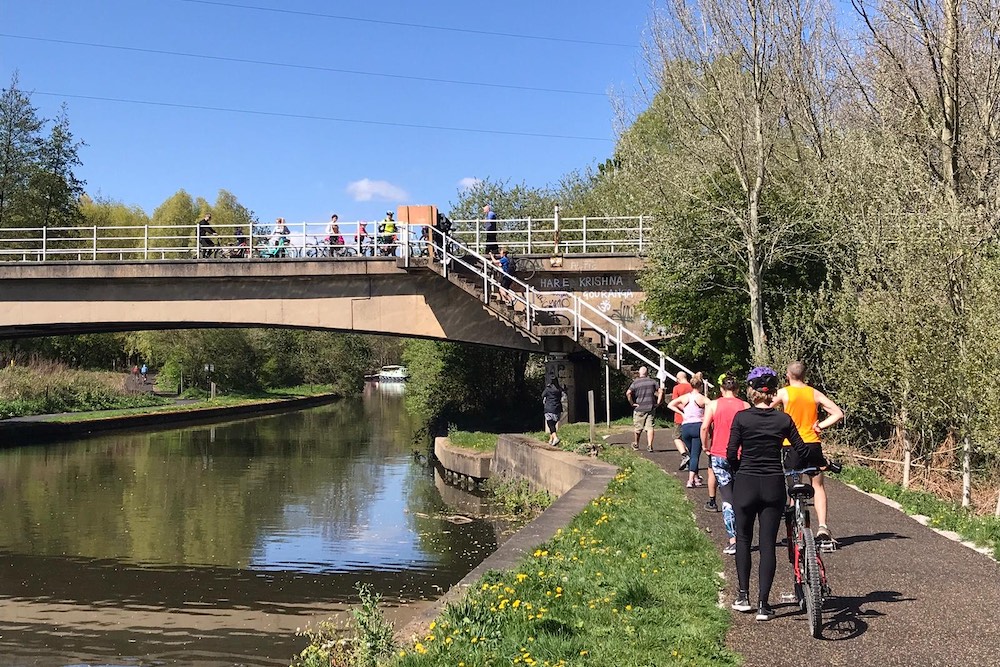
Olympic star, Alistair Brownlee MBE, has leant his support to the campaign (previously reported here) to make major Leeds and regional cycling and walking route accessible to all.
Leeds Cycling Campaign has released a new film highlighting the need for urgent action to provide safe access for cyclists, runners and walkers to the Aire and Calder canal at Skelton Grange Road Bridge.
The canal tow-path forms part of the scenic Trans Pennine Trail and Sustrans’ National Cycle Network.
The steep and often slippery steps at the Bridge make access to the tow-path very difficult for anyone with a bike and impossible for people in wheelchairs or with chronic health conditions. Many riders with e-bikes, families with buggies, mobility scooter users and others with disabilities are likewise prevented from using the Trail.
These steps have been an obstacle for at least 30 years and must be replaced, argues Leeds Cycling Campaign. Access to green space is now widely recognised as vital for peoples’ physical and mental health, but many of the communities living near the route have significantly poorer health than the city average.
Recent improvements to the route and the global pandemic have greatly increased the numbers of people using the area and sharply highlighted the need to provide a safe and accessible crossing at Skelton Grange Road Bridge.
Ambitious Government and City Council plans to reduce car use and increase cycling for commuting and leisure will be impossible to deliver if this major traffic-free route linking Leeds with Wakefield and beyond is not upgraded to make it accessible for everyone.
2,200 people have already signed the Leeds Cycling Campaign petition calling for action.
500 people use this major green highway every day for leisure or commuting avoiding the crowded and dangerous roads into Leeds city centre from the south.
In 2006 a feasibility study undertaken by Leeds City Council recommended a new pedestrian and cycling bridge at Skelton Grange. Another option would involve re-routing the path through the Council owned Thwaites Mill museum.
Leeds Cycling Campaign is working with Leeds City Council, Leeds Local Access Forum, Leeds Civic Trust, Sustrans, the Canals and Rivers Trust and the Friends of the Trans Pennine Trail to explore both these options.
Alistair Brownlee said:
“The Aire and Calder canal tow path has just been resurfaced and is a fantastic active travel corridor. It makes up part of the Trans Pennine Trail and the Sustrans’ National cycle network and is a great commuter route into the city centre. It is a quiet and traffic free path that winds its way through natural and green habitats even though the user is never far from habitation. Promoting and increasing its usage are fantastic causes.
“Unfortunately, at the moment, access to it is restricted to users who can make it down a steep and narrow flight of steps. The creation of a new bridge here would be a very positive step for all of the current users and more importantly open up the path to many more. We all know the importance of health and activity, especially in the current climate. This project would be of real benefit to all parts of the local community.”
Gerri Kostrzewa, Chair of Leeds Cycling Campaign said:
“We believe that both potential solutions need to be explored as a matter of priority, in the interest of public health and active travel. Funding needs to be found to undertake further feasibility work and deliver the best option for everyone as soon as possible.
“We believe that providing access for everyone at Skelton Grange Road Bridge is a major test of our ambition, in Leeds and West Yorkshire, to create a sustainable, safe and socially just city.”
As we reported recently, work is due to be undertaken on the bridge as part of the energy from waste incinerator to be built on the Skelton Grange power station site. The current plans are to strengthen the bridge and allow for two lanes of vehicle traffic. A new cantilevered 3m wide footpath and cycleway will be added and an access ramp created on the south bank of the canal. The steps to access the Trans Pennine Trail will be replaced with wider (1.3m) steps, but no ramp is planned. Whilst this may ease some of the congestion of people queing to use the steps, it does nothing resolve access for disabled people, parents with buggies, those with electric bikes, etc.
This post is based on a press release issued by Leeds Cycling Campaign



This is a brilliant idea hope the campaign suceeds. It should be same for all similar locations. As a disabled person I find it so difficult to use the beautiful waterside locations in alot of places. I find this such a shame as the tranqulity is so soul inspiring.
I use this route on my pleasure rides from Leeds to Wakefield, and I find it to be more of a challenge when it comes to the bridge. I was once younger where I would just pick up my bike and carry it, but now just like everyone else age is on my side. So it would be great to have a easy access all the way through. And I hope one day. If not for me, but all over generation this can be made possible.
Wouldn’t it be easier to make a access point to the towpath a little higher upstream or downstream Then there’s no need to use the steps.
There is another alternative , which is to open up the route at the back through the old power station site and rejoining at the M1 bridge. You can actually do it now avoiding the steps but you still have to lift your bike over the concrete road blocks at the end
This is not a solution for wheelchairs, but could a “channel” be installed so that cycles can be more easily wheeled up? I have seen such devices in London and other places